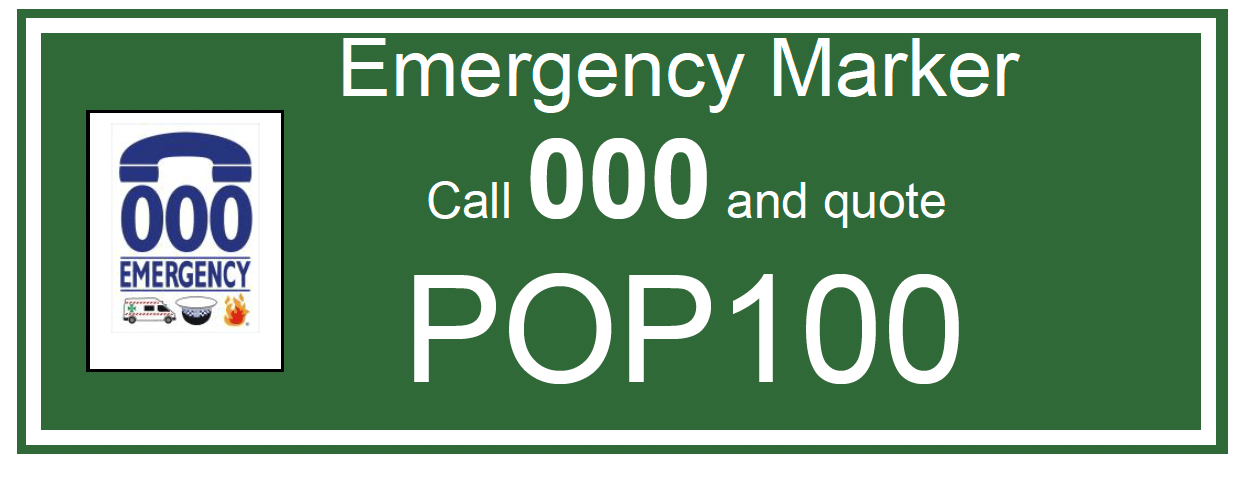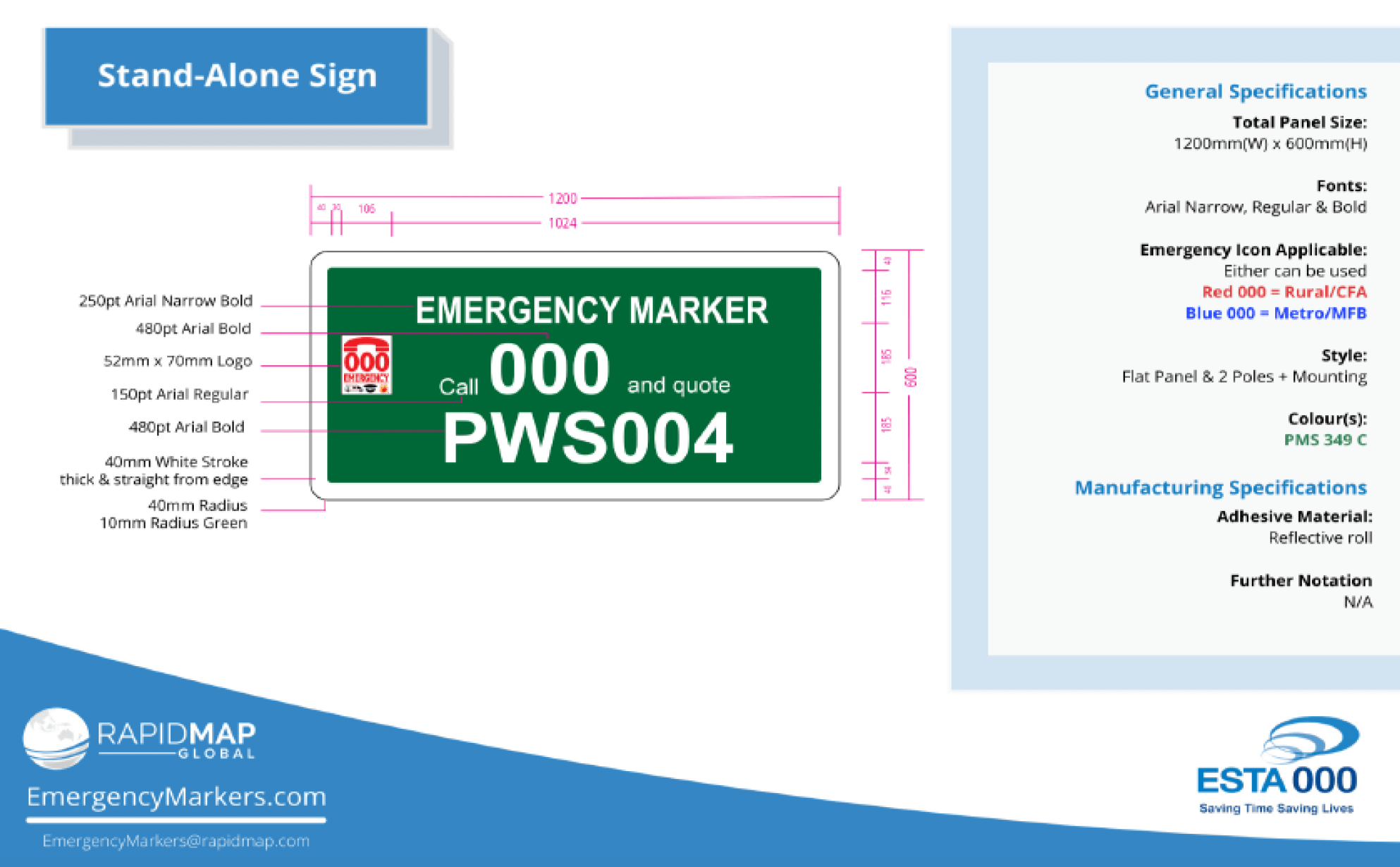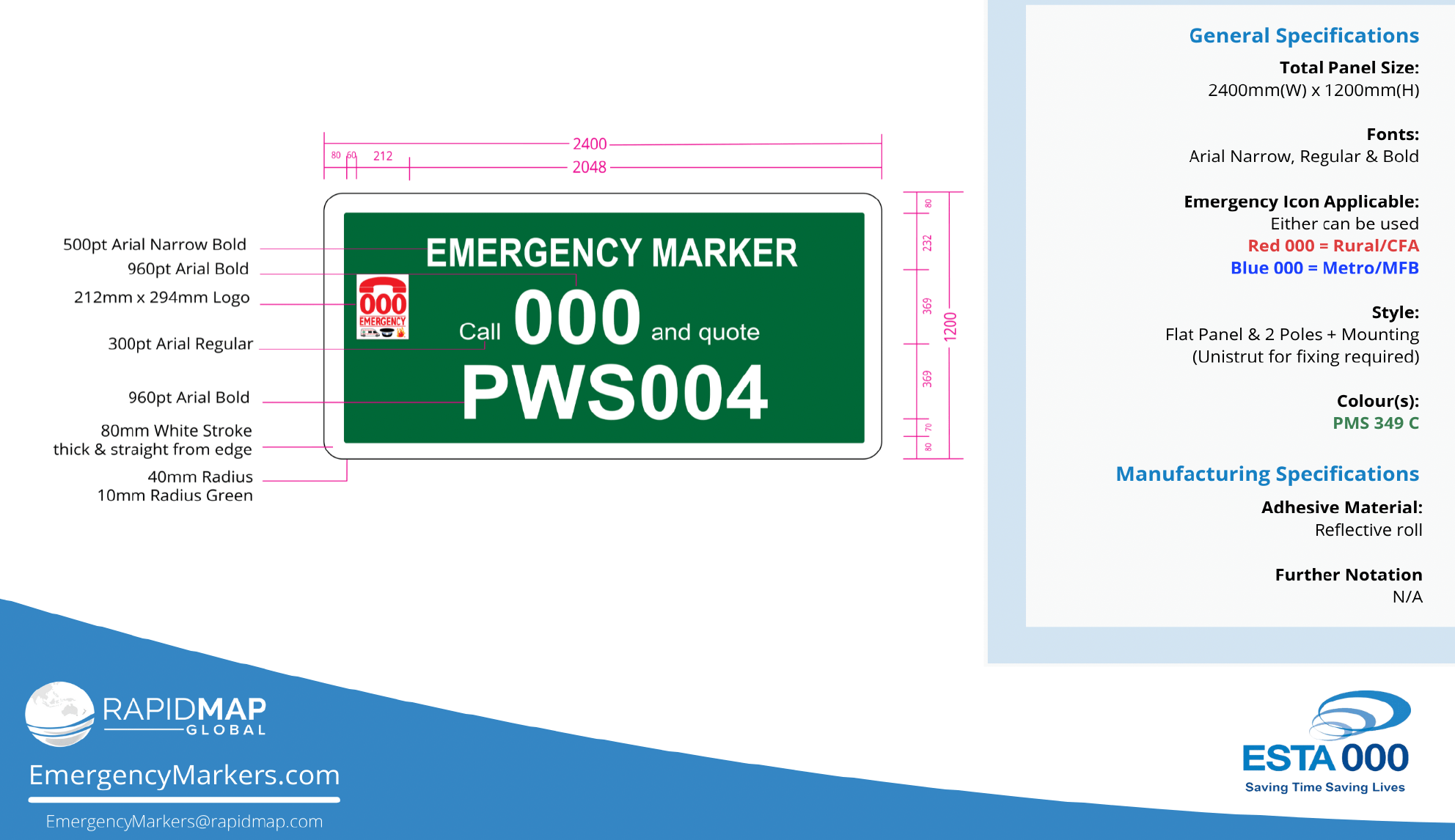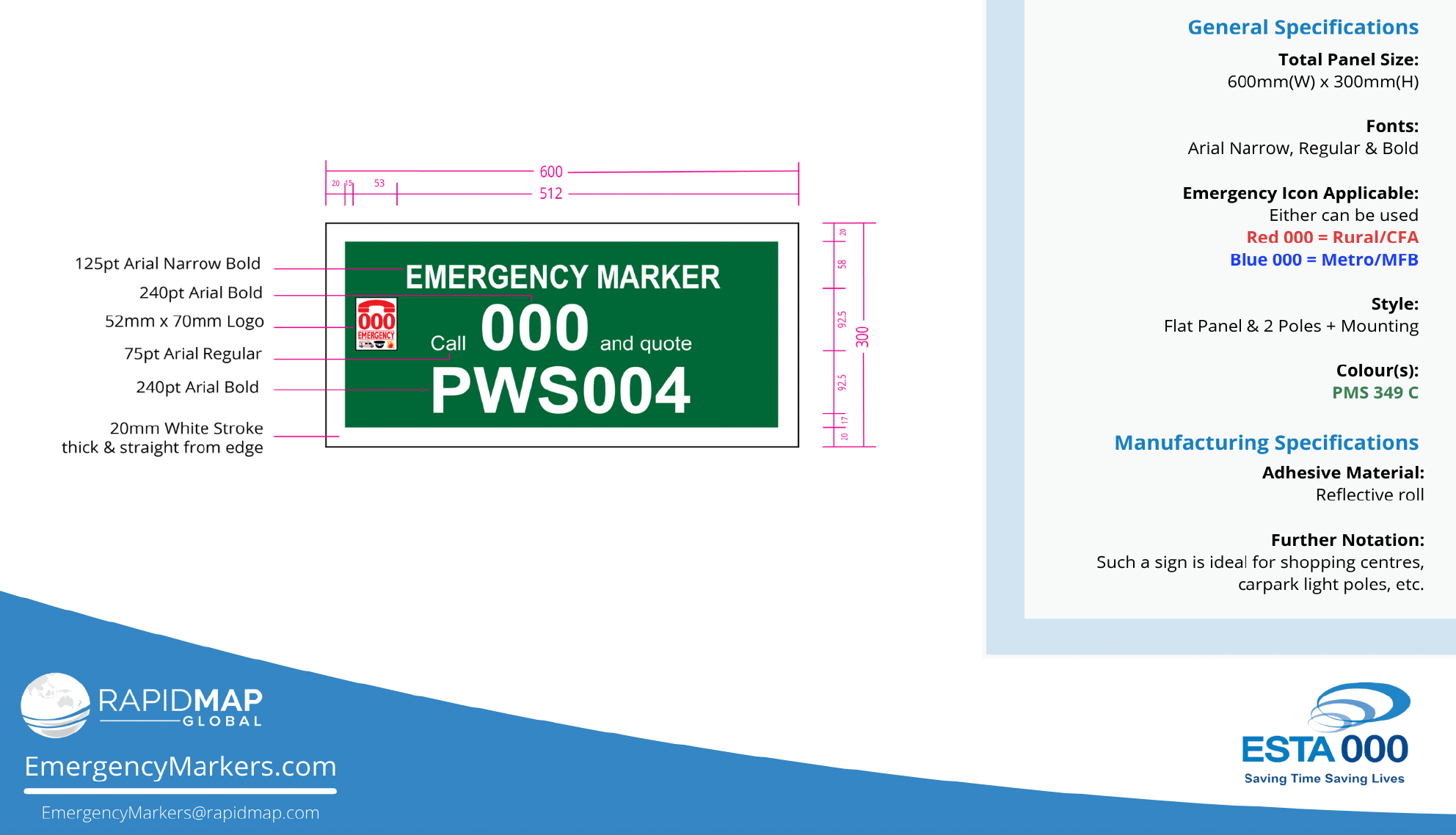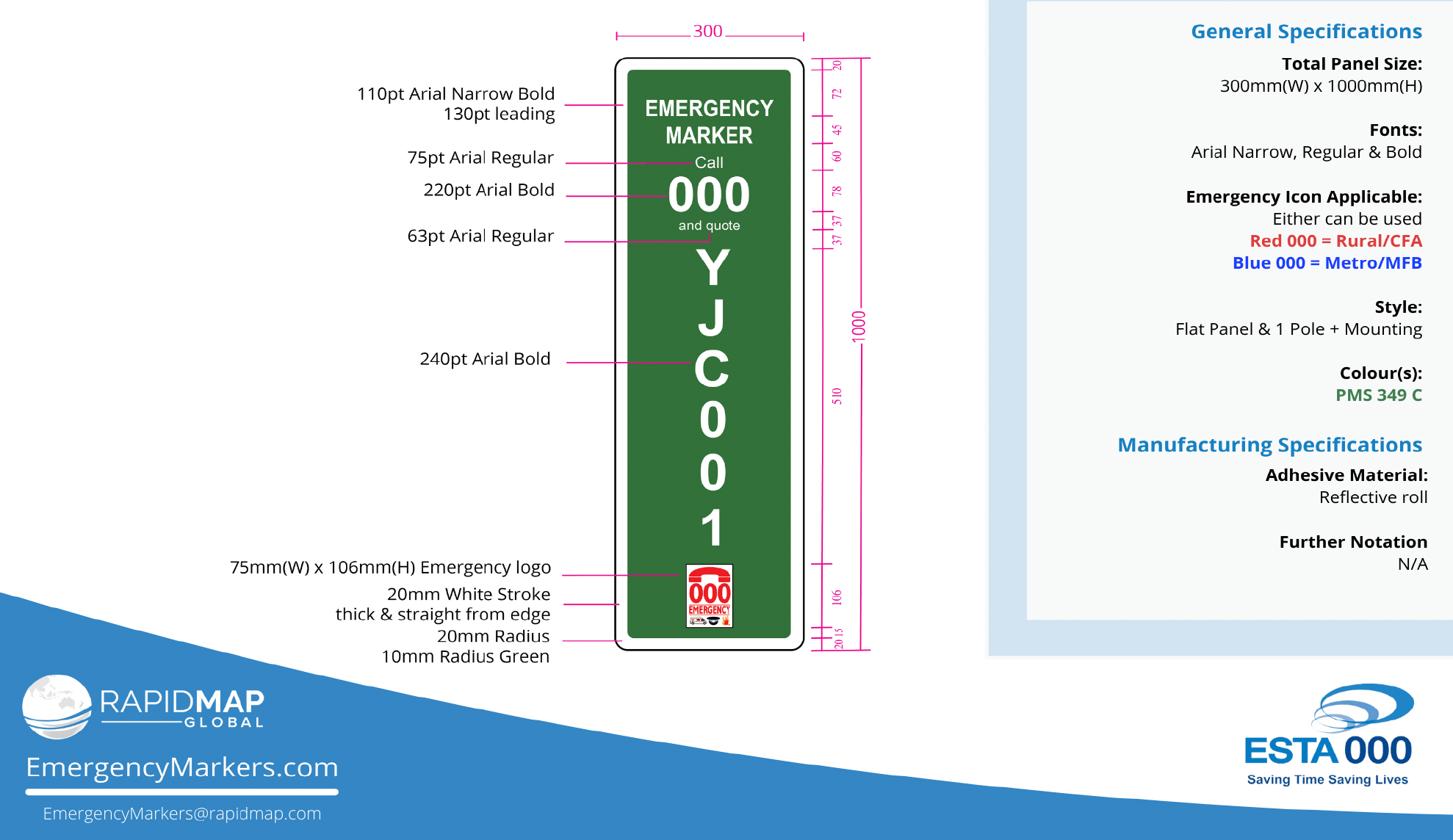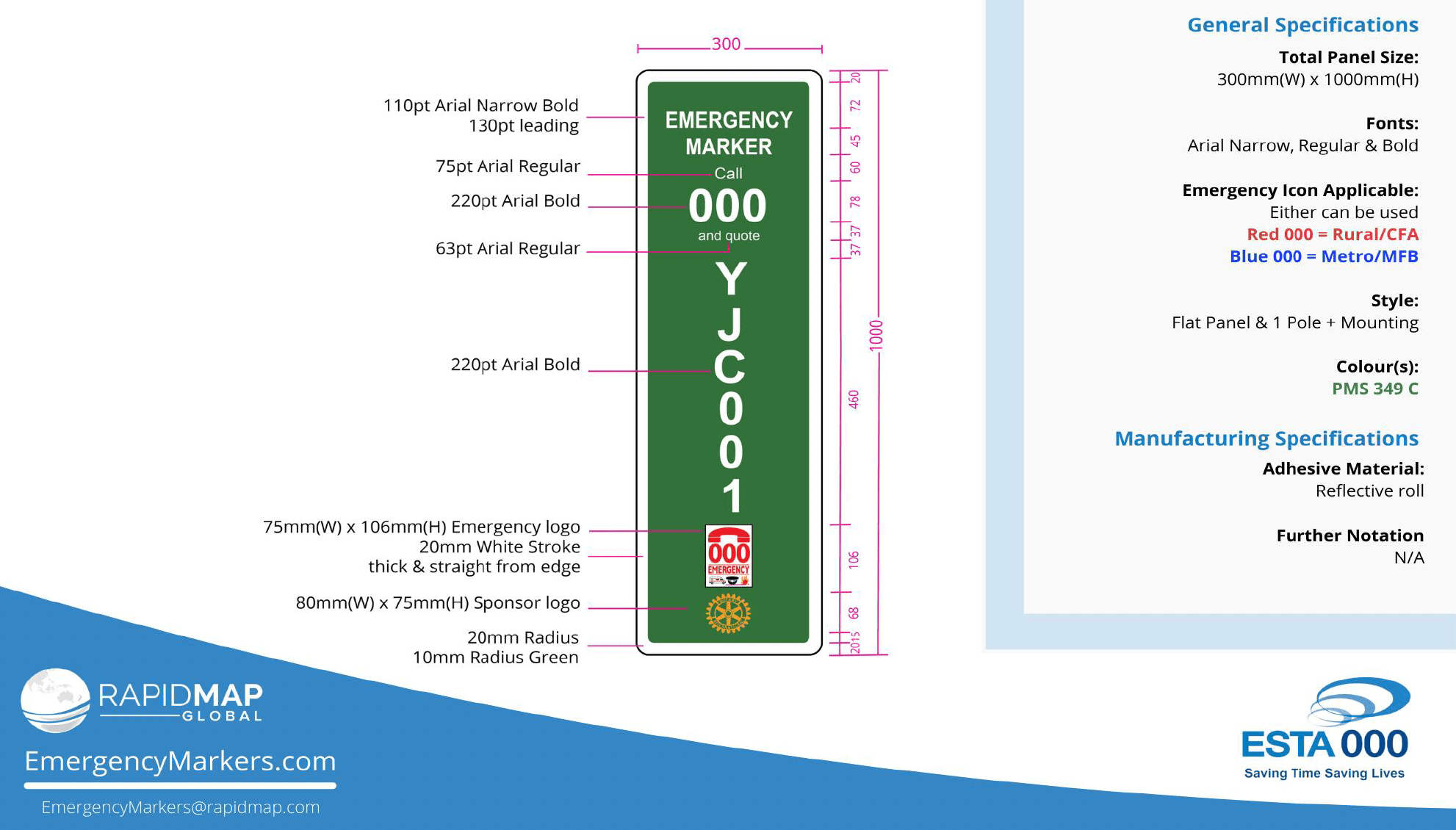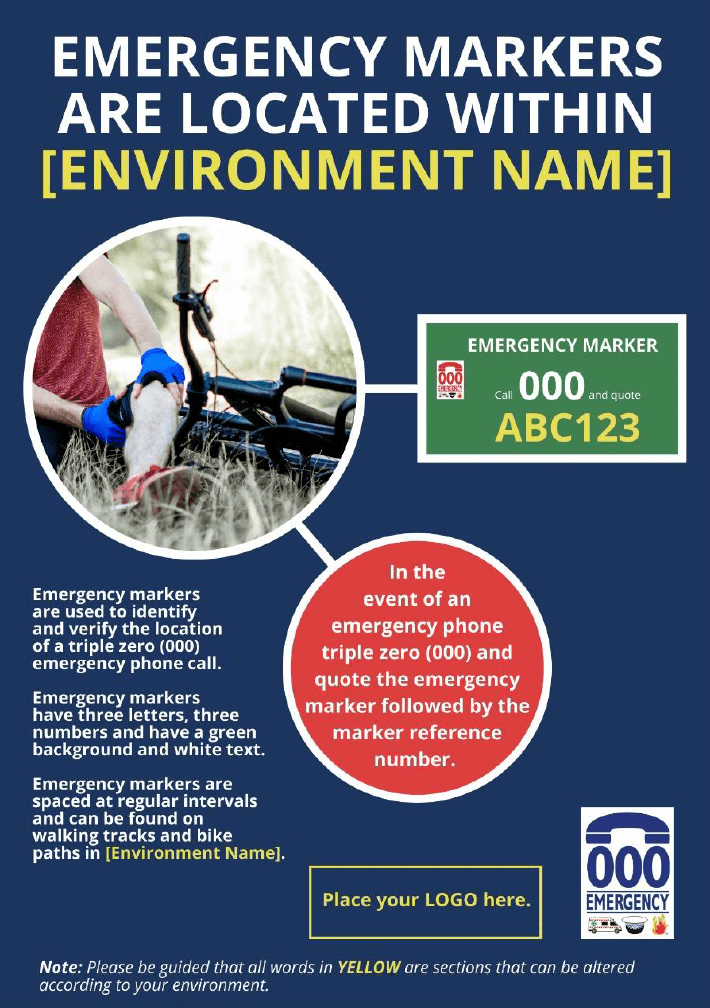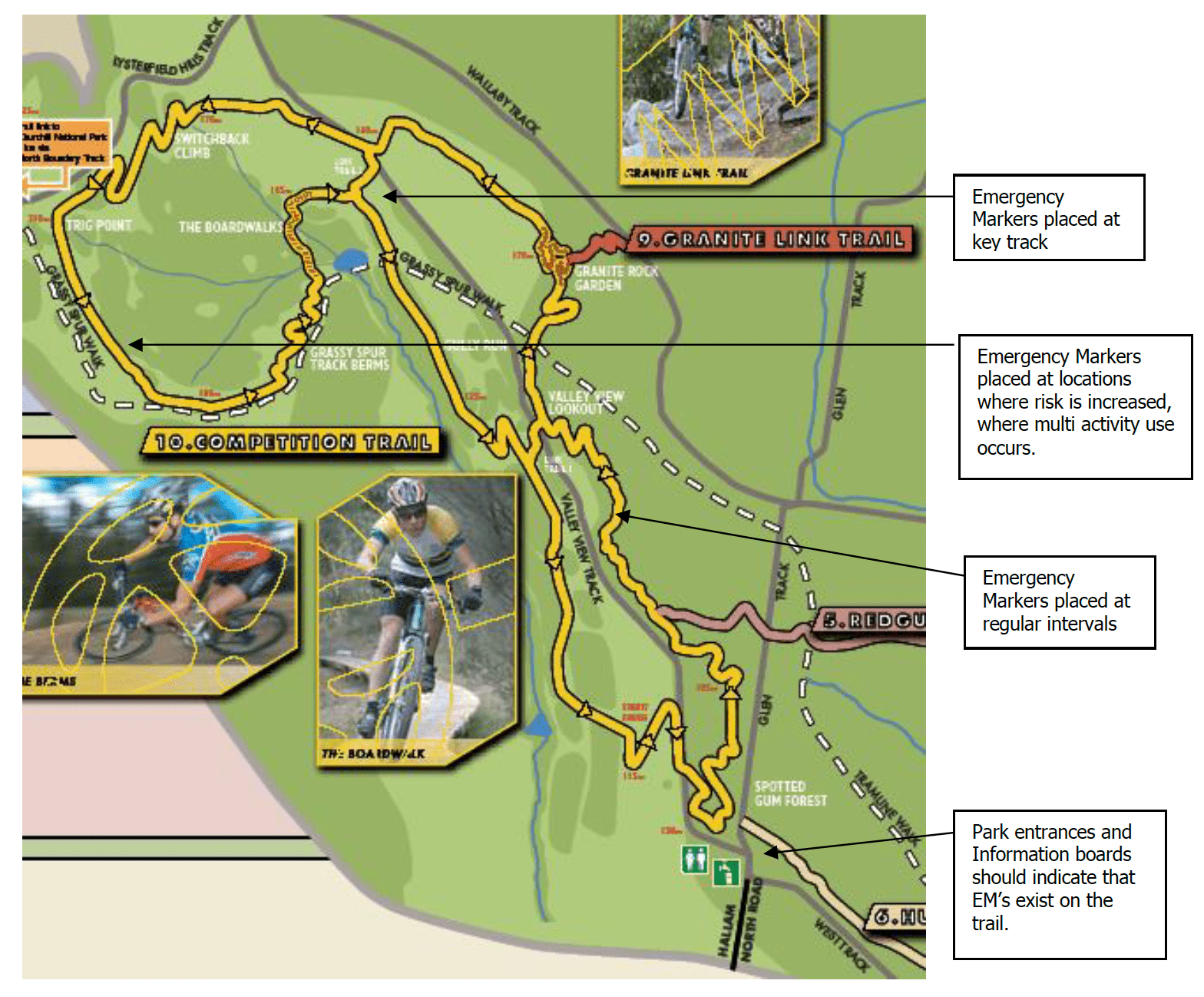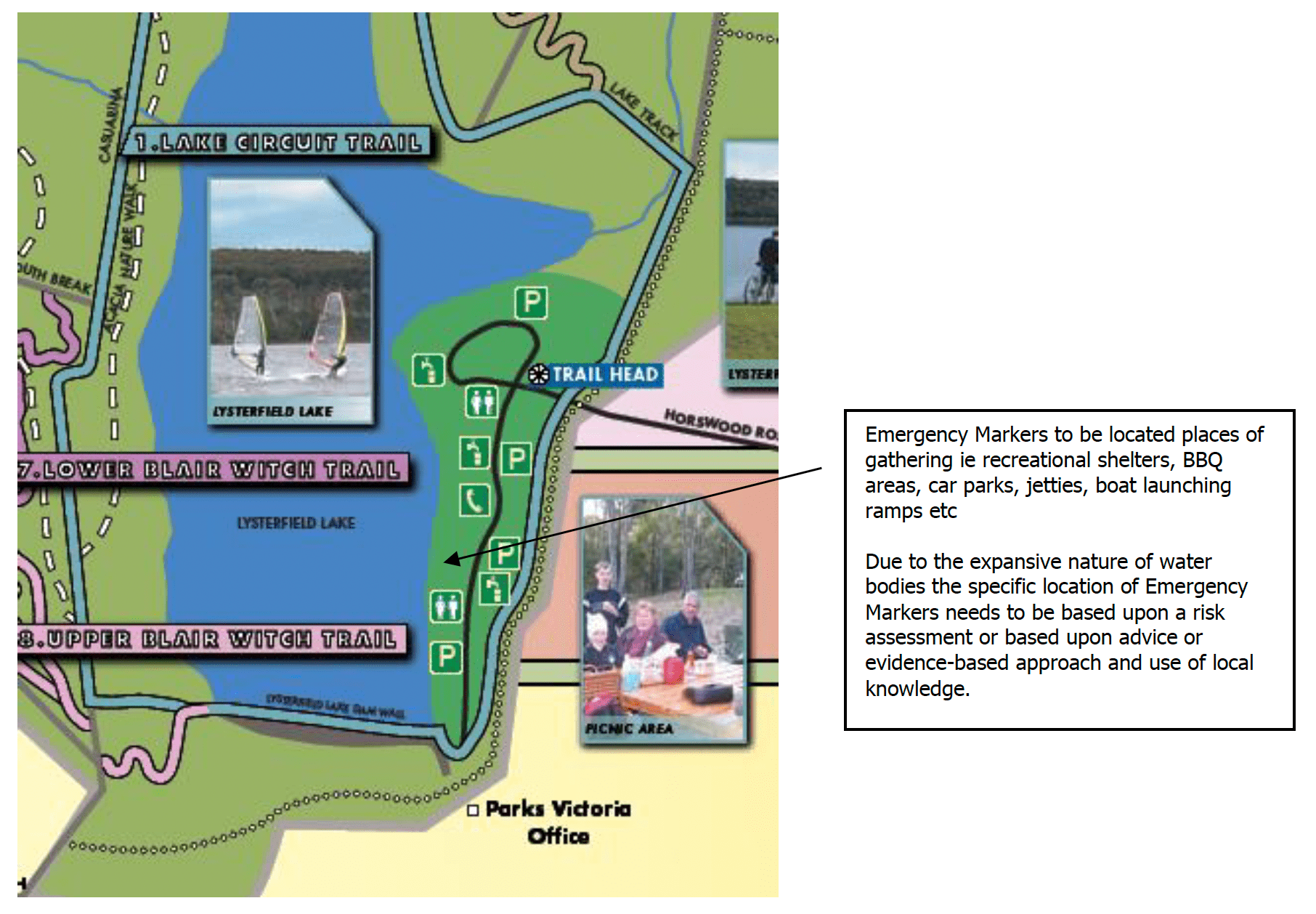The purpose of this guidance is to:
- establish design guidelines that will enable the responsible landowners and land managers to implement emergency markers in a consistent manner
- assist landowners and managers in identifying suitable locations for the installation of emergency markers.
Identifying the location of the emergency triple zero call is the first and most critical element in the delivery of timely and accurate emergency response services to Victorians.
The ability of Triple Zero Victoria to direct an emergency response team to precise emergency caller locations is a critical and core component of the Call-taking and Dispatch management process for all triple zero emergency calls.
Emergency marker purpose
Determining caller location is the most critical piece of information used by emergency call takers to dispatch emergency personnel and resources. This is a fundamental requirement for the operation of any modern Emergency Call Service and apart from the actual call itself, is the next most vital piece of information, since without it, Emergency Service Organizations (ESOs) may be limited in the level assistance they can offer to the caller.
Currently when a Triple Zero call is made on a fixed line the Emergency Call Person (ECP - Telstra) receives the subscribers billing address (CLI -Caller Line Information) which is generally the location of the Triple Zero caller. This information is presented to Triple Zero Victoria by Telstra when the call is transferred.
However, when a Triple Zero call is made from a mobile phone Triple Zero Victoria receives the mobile billing address. In most cases this is not the actual location of the caller, or the location of the emergency event.
Emergency markers enable Triple Zero Victoria's Call-takers to immediately and accurately verify the location of an emergency 000 call in public open space.
The two most important pieces of information required when calling Triple Zero are the location of the emergency (where is it?) and the nature of the emergency (what is it?). Emergency markers aim to improve response times in the event of an emergency triple zero call. They do not eliminate the risk nor will they mitigate the likelihood of event occurring.
Emergency marker design standards
This document aims to ensure that emergency markers are manufactured, installed, and maintained in accordance with established and compatible Australian and International standards.
As there is no dedicated Australian or International Standard relating to emergency markers, the following compatible standards should be used to guide the manufacturing process for emergency markers.
- AS/NZS 2416:3:2010 Water safety signs and beach safety flags, Part 1, 2 & 3: Sydney, NSW: Standards Australia.
- National Aquatic and Recreational Signage Style Manual – Third edition
- Other relevant standards are
- AS1319-1994 – Safety Signs for the Occupational Environment,
- ISO 7010:2003 AMD 4– Safety Colors and safety signs used in workplaces and public areas.
- ISO 7010 AMD 9 - Safety signs for the purposes of accident prevention, fire protection, health hazard information and emergency evacuation.
Design principles
The principles outlined are intended to provide assistance to landowners and managers in ensuring that emergency markers have been considered and applied using a consistent and standardised format.
It is intended that these guidelines act as an enabling tool, allowing the responsible authority flexibility in designing, manufacturing, and installing emergency markers.
No two emergency marker environments are the same and therefore it is impractical to set prescriptive criteria for the placement of emergency markers. It is intended that emergency markers be installed using a performance-based approach.
Marker design and manufacturing parameters
As a guide emergency markers must:
- Be highly durable and weather resistant according to the environment.
- Materials should be selected to meet the needs of each environment but stay within the design parameters defined within this document.
- Emergency markers dimensions should relate to the scale of the landscape setting in which they are to be placed.
- Can be stand alone or attached to existing infrastructure.
- Marker orientation can be portrait or landscape.
- Font size must be identifiable from a practical distance.
- Emergency marker material should be graffiti resistant and UV stabilized.
- Emergency markers can be installed as a standalone sign or incorporated within an existing sign.
Emergency marker specifications
The following rules should be adhered to when designing and manufacturing emergency markers:
Emergency markers are required to meet the following text and font standards
- Text: Arial Bold reversed out of Green PMS 349c
- Background Panel Colour: Green PMS 349c
- Font and Colour: Arial Narrow Efo Mt Bold – White
- Text Font & Colour: Arial (Directions) Arial Bold (000) – White
- White Border/outline/stroke at the sign.
- Marker font size must be identifiable from a practical distance and optically spaced. White letters on a green background are most identifiable for the human eye and meet the needs of individuals with colour deficient vision.
- The use of the National triple zero symbol and/or pictograms should be used wherever possible.
Emergency marker installation
The location and placement of emergency markers must not present an obstacle or hazard to users of the environment.
Emergency markers should also:
- Be at least one metre off the edge of any trail and should consider the approach speed and space required to maneuver without impeding the pathway for other trail users.
- Should be at least 1.2 – 1.7metres off the ground emergency markers should be placed where they do not distract the users during high-risk activities i.e., mountain bike riding.
- Obstacles must not obscure the line of sight of the emergency marker. Emergency markers should be placed where their presence does not create a hazard or obscure other hazards.
- Emergency markers should avoid locations where the vegetation or surrounding physical features reduce the emergency markers' impact or line of sight vision.
Emergency marker placement
Emergency marker locations should be identified through the application of the AS/NZS ISO 31000:2009 Risk Management. Elements of likelihood and consequence should constitute the basis on which emergency marker locations are prioritised.
Effective placement and installation of emergency markers cannot be underestimated. Placement, height, orientation, and size are critical components in determining the effectiveness of the marker.
Emergency markers can be installed, at the following locations:
- Locations with a history of emergency events or known incident sites.
- Locations or facilities that have high visitation numbers or are visited by people who are unfamiliar with the locality,
- Locations offering higher risk activities to the visitor, eg. Mountain bike riding, rock climbing, abseiling etc.
- Shared activity locations
- Walking trails and shared paths – Emergency Markers should be located at, trail junctions and significant features such as congregation points, shelters
- Linear trails Rail trails and other similar assets should have Emergency Markers placed at regular intervals varying from 500m to 1klm
- At Water bodies, and swimming holes, beach access tracks
- Piers and Jetties should have a marker at the beginning and end of the infrastructure.
- Remote areas that act as a thoroughfare or receive significant visitation
- Recreational playgrounds with no verifiable address points or visible naming convention.
- Critical infrastructure locations.
Emergency markers may not be required
There are many instances in public open spaces where emergency markers are NOT required. Examples of these locations are,
- Locations which can be attributed to a verifiable road intersection or road segment.
- Locations which are listed as common place names and can be identified and verified within Triple Zero Victoria’s Call-taking and Dispatch (CAD) system.
- Locations where the facility, asset or site is, or can be, named and identified in CAD as a feature of interest or
- Locations within viewing distance from a street sign or has a registered naming convention.
- Locations where trail junctions, or the paths are within viewing distance of a known feature.
Frequency of emergency markers
The level of signage needs to be proportional to the level of risk, frequency, and type of activity use. Generally, the greater the visitation rate, the broader the activity range and the higher risk, the more frequent the location of emergency markers signage should be.
Where there is a continuous trail or path such as a Rail trails, linear bike paths, river trails, and beaches
- Emergency markers should be installed at regular intervals; and can be spaced every 500m or 1000m. The final decision sits with the landowner/manager.
- Where the direct line of sight is restricted by terrain, vegetation markers can be installed at 250m or less intervals.
Viewing distance
It is recommended that any symbols be at least 15mm per metre of viewing distance, and any upper-case text be at least 5mm per metre of viewing distance. This should be increased under poor lighting or viewing conditions. Where practical, EM’s should be mounted close to the observer’s line of sight in the vertical plane.
Unique alpha-numeric code
The six-character unique alpha-numeric identifier is linked to Triple Zero Victoria’s computer aided dispatch system (CAD) and specifies relevant location, GPS coordinates, road access route or navigational data for the expedient dispatch of emergency services.
Emergency markers should be considered by landowners, land managers, Committees of Management as part of their overall risk assessment and treatment process. Emergency markers should be integrated into open space strategies and policies wherever deemed applicable.
Alpha configuration
The alpha section of the identification system should be used to identify the emergency marker environment by name. This can be done in several ways to clearly identify the park.
The following examples may be used:
- First 3 letters of the park name, e.g. MOR for Mornington Peninsula National Park
- First letter of each word, e.g. MPN for Mornington Peninsula National (Park)
- First 2 letters of the park name, plus first letter of unit name for large parks, e.g. ANP for Alpine National Park, DVP for Dandenong Valley Parklands.
Numeric configuration
The numeric section of the emergency marker system can be used to identify the visitor setting and the specific location.
Numerical values can be divided into categories. The first number of the three-digit numeric code should represent the type of visitor setting:
- Car park
- Day use area (e.g., picnic area, gardens, playgrounds)
- Camping area
- Built Assets
- Trails
- Roads
- Open Space
- Water Bodies (e.g., visitor sites on beaches, rivers, lakes)
- Access points
Note: These categories are not mandatory and act as a guide only.
Numerical values can also be structured to increase incrementally e.g., MTM100, MTM101, MTM102 etc to ensure that there is an understandable and logical sequence. This method occurs more often on linear trails. Increments can occur in fives or tens to allow for the addition of future markers.
Emergency marker indexing
To ensure consistency of indexing configurations of emergency markers a six-character alphanumeric identification system has been developed.
The following rules should be adhered to for Marker indexing:
- All emergency markers will have a unique Alpha Numeric code (Index). This is provided by Triple Zero Victoria.
- Marker indexing must be unique to each environment with no duplications
- Marker indexing must uniquely identify each individual emergency marker within that environment.
- Marker indexing must be mutually exclusive (no duplication in indexes across emergency markers)
- Marker indexing must be compliant with the data conventions of Triple Zero Victoria's CAD system and manual operating systems.
- Marker indexing must contain three Alpha and three Numeric characters.
Mobile phone coverage and emergency markers
In areas where there is no mobile coverage, triple zero callers will still be asked “Where is your emergency” and “what are the names of the nearest intersection” when they are able to dial out for assistance
Where emergency markers have been installed in areas with no mobile phone coverage the emergency marker still acts as a verifiable point of reference and will greatly assist in dispatching services more accurately. This Saves Time and may Save Lives.
Emergency marker costs
Triple Zero Victoria has outsourced the data collection and processing of emergency markers to long term partners RapidMap. RapidMap team scopes the amount of work involved for the collection and processing of associated spatial data and charges a cost recovery fee to the landowner/manager. This fee is completely dependant on the type of environment and number of emergency markers to be installed.
EM Manufacturing and installation costs are the responsibility of the landowner/manager.
There are no annual or recurrent costs.
To get the estimate on cost please contact Triple Zero Victoria at emergency.markers@triplezero.vic.gov.au or RapidMap at emergencymarkers@rapidmap.com.
Emergency marker maintenance
- Emergency markers are the responsibility of the landowner or land manager
- Marker maintenance is the primary responsibility of the landowner
- Marker maintenance audits should be carried out on a routine, scheduled basis. Audits must be conducted annually with the results of any damaged or illegible markers conveyed to Triple Zero Victoria
- Marker maintenance should include cleaning and repair to ensure visibility of emergency markers is not impeded (i.e., graffiti)
- Marker maintenance that results in any change to the number of emergency markers or the data associated with emergency markers requires immediate notification to the appropriate authority
- Marker maintenance should consider environment changes requiring updates to existing emergency markers (e.g., change of infrastructure to which emergency markers are attached etc.).
Marker relocation or removal
Emergency markers can be relocated or removed if the following process is adopted:
- The landowner notifies Triple Zero Victoria in writing of their desire to relocate emergency markers
- GPS coordinates of the proposed new marker location are sent to Triple Zero Victoria enabling new location to be spatially located
- Authority to relocate or install new emergency markers must be approved by Triple Zero Victoria
- All new directional data must be gathered, entered, and tested in Triple Zero Victoria's CAD system prior to any new signage being relocated, removed, or installed
- Marker maintenance that results in any change to the number of emergency markers or the data associated with emergency markers requires notification to Triple Zero Victoria for addition/update to the CAD system.
Alternatives to emergency markers
Emergency markers are one treatment in being able to verify the location of a triple zero call. In addition to emergency markers Public Landowners and managers can also improve the naming conventions of roads, tracks, and trails in public land.
To do this, landowners and managers can act as the custodian of the data and provide the following to DEPI – Department of Environment and Primary Industries:
- register unnamed roads, tracks and trails
- allocate or provide names of features, points of interest and other unique locations. This will enable Triple 000 call takers to verify the location of the emergency call.
This data will then be incorporated into the VicMap data, which is used by Triple Zero Victoria and Emergency Service Organisations.
A place name will not provide directional instructions if it is a location that is away from a known intersection or feature. In this case emergency markers may well be a stronger treatment. In many circumstances it is advisable to do both. The naming convention gives it a known reference point and emergency markers provide the critical information for ESOs to navigate to that location.
Appendices
Appendix 1: Emergency markers design
Stand-alone signs
Stand-alone signs (large)
Access points sign
Shared pathways sign
Shared pathways sign (with sponsor logo)
Emergency marker poster
Appendix 2: Guide to emergency marker positioning
Appendix 3: Guide to emergency marker positioning – water bodies
Emergency markers are required at water bodies where recreational activities occur.
Appendix 4: Emergency marker design, manufacture criteria and signage materials
Refer to our online guide: emergency marker design and manufacture criteria.
Appendix 6: Triple zero process
Refer to our webpage about calling triple zero (000) from an emergency marker.
Updated


